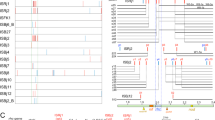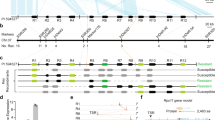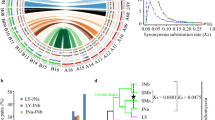Abstract
To select for bacterial strains with enhanced phenotypes, random fragments of a whole genome, or a defined region of the genome, are cloned in a nonreplicating vector. The resulting plasmids are integrated by recombination into the homologous DNA region of the original strain. Integration gives rise to a nontandem direct duplication of the corresponding DNA region separated by the vector moiety of the plasrtiid. Recombination between the direct repeats leads to tandem duplication and further amplification Of the entire integrated DNA, including the vector. Bacteria harboring the amplified DNA are selected by increasing the dosage of an antibiotic corresponding to a resistance marker of the integrated vector. Pooled strains carrying amplifications are then challenged with a selective pressure for the desired phenotype. After repeated selection cycles, the most fit strains are isolated. We used this process, which we called random DNA amplification, to select Rhizobium strains with increased competitiveness for nodule formation. Derivatives containing randomly amplified DNA regions of the symbiotic plasmid of Rhizobium tropici CFN299 strain were generated. Pools of amplified strains were inoculated onto various tropical legumes. After several cycles of selection through plants, amplified derivatives showing an increased competitiveness for nodule formation with the leguminous plant Macroptilium atropurpureum were obtained.
This is a preview of subscription content, access via your institution
Access options
Subscribe to this journal
Receive 12 print issues and online access
$209.00 per year
only $17.42 per issue
Buy this article
- Purchase on Springer Link
- Instant access to full article PDF
Prices may be subject to local taxes which are calculated during checkout
Similar content being viewed by others
References
Anderson, P.P. and Roth, J.R. 1997. Tandem genetic duplications in phage and bacteria. Annu. Rev. Microbiol. 31: 473–505.
Petes, T.D. and Hill, C.W. 1988. Recombination between repeated genes in microorganisms. Annu. Rev. Microbiol. 22: 147–168.
Neuberger, M.S. and Hartley, B.S. 1981. Structure of an experimentally evolved gene duplication encoding ribitol dehydrogenase in a mutant of Klebsiella aerogenes. J. Gen. Microbiol. 122: 181–191.
Sonti, R.V. and Roth, J.R. 1989. Role of gene duplications in the adaptation of Salmonella typhimuriurti to growth on limiting carbon sources. Genetics 12319–28.
Ghosal, D., You, I.-S., Chatterjee, O.K. and Chakrabarty, A.M. 1985. Genes specifying degradation of 3-chlorobenzoic acid in plasmids pAC27 and pJP4. Proc. Natl. Acad. Sci. USA 82: 1638–1642.
Mekalanos, J.J. 1983. Duplication and amplification of toxin genes in Vibrio cholerae . Cell 35: 253–263.
Corn, P.G., Anders, J., takala, A.K., Kayhty, H. and Hoiseth, S.K. 1993. Genes involved in Haemojphilus influenzae type b capsule expression are fre-quently amplified. J. Infect. Dis. 167: 356–364.
Peterson, B.C. and Rownd, R.H. 1985. Drug resistance gene amplification of plasmid NR1 derivatives with various amounts of resistance determinant DNA. J. Bacteriol. 161: 1042–1048.
Flores, M., Brom, S., Stefjkowski, T., Girard, M.L., Davila, G., Romero, D. et al. 1993. Gene amplification in Rhizobium: Identification and in vivo cloning of discrete amplifiable DNA regions (amplicons) from Rhizobium leguminosarum biovar phaseoli. Proc. Nail. Acad. Sci, USA 90: 4932–4936.
Roth, J.R., Benson, N., Gblitski, T., Haack, K., Lawrence, J.G. and Miesel, L. 1996. Rearrangements of the bacterial chromosome: formation and applications, pp. 2256–2276 in: Escherichia coli and Salmonella typhimurium: cellular and molecular biology, 2nd. ed. Neidhardt, F.C., Curtiss III, R., Ingrham, J.L., Lin, E.C.C., Low Jr., K., Magasanik, B., et al. (eds.) American Society for Microbiology Press, Washington, DC.
Albertini, A.M. and Galizzl, A. 1985. Amplification of a chromosomal region in Bacillus subtilis J. Bacteriol. 162: 1203–1211.
Kallio, P., Palva, A. and Palva, I. 1987. Enhancement of α-amylase production by integrating and amplifying the α-amylase gene of Bacillus amyloliquefaciens in the genome of Bacillus subtilis . Appl. Microbiol. Biotechnol. 27: 64–71.
Fisher, R.F. and Long, S.R. 1992. Rhizobium-plant signal exchange. Nature 357: 655–660.
Denarie, J., Debbelle, F., and Rosenberg, C. 1992. Signaling and host range variation in nodulation. Annu. Rev. Microbiol. 46: 497–531.
Schultze, M., Kondorosi, E., Ratet, P., Buire, M. and Kondorosi, A. 1994. Cell and molecular biology of Rhizobium-plant interactions. Int. Rev. Cytol. 156174.
Martinez-Romero, E. and Caballero-Mellado, J. 1996. Rhizobiumphylogenies and bacterial genetic diversity. Crit. Rev. Plant Sci. 15: 113–140.
Honeycutt, R.J., McClelland, M. and Sobral, B.W.S. 1993. Physical map of the genome of Rhizobium meliloti1021. J. Bacteriol. 175: 6945–6952.
Banfalvi, Z., Sakanyan, V., Koncz, C., Kiss, A., Dusha, I. and Kondorosi, A. 1981. Location of nodulation and nitrogen fixation genes on a high molecular weight plasmid of Rhizobium meliloti . Mol. Gen. Genet. 184: 318–325.
Rosenberg, C., Boistard, P., Denarie, J. and Casse-Delbart, F. 1981. Genes controlling early and late functions in symbiosis are located on a megaplas-mid in Rhizobium meliloti . Mol. Gen. Genet. 184: 326–333.
Flores, M., Gonzalez, V., Brom, S., Martlnez, E., Pinero, D., Romero, D. et al. 1987. Reiterated DNA sequences in Rhizobium and Agrobacterium . J. Bacteriol. 169: 5782–5788.
Flores, M., Gonzalez, V., Pardo, M.A., Leija, A., Martinez, E., Romero, D. et al. 1988. Genomic instability in Rhizobium phaseoli . J. Bacteriol. 170: 1191–1196.
Romero, D., Brom, S., Martinez-Salazar, J., Girard, M.L., Palacios, R. and Davila, G. 1991. Amplification and deletion of a nod-nifregion in the symbi-otic plasmid of Rhizobium phaseoli . J. Bacteriol. 173: 2435–2441.
Romero, D., Martinez-Salazar, J., Girard, L., Brom, S., G-, Palacios, R., et al 1995. Discrete amplifiable regions (amplicons) in the symbiotic plasmid of Rhizobium etliCFN42. J. Bacteriol. 177: 973–980.
Martinez-Romero, E., Segovia, L., Mercante, F.M., Franco, A.A., R, and Pardo, M.A 1991. Rhizobium tropici, a novel species nodulating Phaseolus vulgaris L. beans and Leucaena sp. trees. Int. J. Syst. Bacteriol. 41: 392–394.
Martinez, E., Palacios, R. and Sanchez, F. 1987. Nitrogen-fixing nodules induced by Agrobacterium tumefaciens harboring Rhizobium phaseoli plas-mids. J. Bacteriol. 169: 2828–2834.
Hernandez-Lucas, I., Segovia, L., Martinez-Romero, E. and Pueppke, S.G. 1995. Phylogenetic relationships and host range of Rhizobium spp. that nodulate Phaseolus vulgaris L. Appl. Environ. Microbiol. 61: 2775–2779.
Hollander, M. and Wolfe, D.A. 1973. Nonparametric statistical methods. John Wiley & Sons, Inc., New York.
Dowling, D.N. and Broughton, W.J. 1986. Competition for nodulation of legumes. Annu. Rev. Microbiol. 40: 131–157.
Triplet!, E.W. 1990. The molecular genetics of nodulation competitiveness in Rhizobium and Bradyrhizobium . Mol. Plant-Microbe Interact. 3: 199–206.
Bromfield, E.S.P., Lewis, D.M. and Barran, L.R. 1985. Cryptic plasmid and rifampicin resistance in Rhizobium meliloti influencing nodulation competi-tiveness. J. Bacteriol. 164: 410–413.
Sanjuan, J. and Olivares, J. 1991. Multicopy plasmids carrying the Klebsiella pneumoniae nifAgene enhance Rhizobium meliloti nodulation competitiveness on alfalfa. Mol. Plant-Microbe Interact.
Seattle, G.A. and Handelsman, J. 1993. Evaluation of a strategy for identify-ing nodulation competitiveness genes in Rhizobium leguminosarum biovar phaseoli . J. Gen. Microbiol. 139: 529–538.
van Rhijn, P.J.S., Feys, B., Verreth, C. and Vanderleyden, J. 1993. Multiple copies of nodD in Rhizobium tropici CIAT899 and BR816. J. Bacteriol. 175: 438–447.
Vargas, C., Martinez, L.J., Megias, M. and Quinto, C. 1990. Identification and cloning of nodulation genes and host specificity determinants of the broad host range Rhizobium leguminosarum bv. phaseoli strain CIAT899. Mol. Microbiol. 4: 1899–1910.
F, Voets, T, Vlassak, K., Vanderleyden, J., and van Rhijn, P 1995. The nodS gene of Rhizobium tropicistrain CIAT899 is necessary for nodulation on Phaseolus vulgaris and on Leucaena leucocephala . Mol. Plant-Microbe Interact. 8: 147–154.
Folch-Mallol, J.L., Marroqut, S., Sousa, C., Manyani, H., Lopez-Lara, I.M., van der Drift, K.M.G.M. 1996. Characterization of Rhizobium tropiciCIAT899 nodulation factors: the role of nodH and nodPQ genes in their sulfation. Mol. Plant-Microbe Interact. 9: 151–163.
Laeremans, T., Caluwaerts, I., Verreth, C., Rogel, M.A., Vanderleyden, J. and Martinez-Romero, E. 1996. Isolation and characterization of the Rhizobium tropici Nod factor sulfation genes. Mol. Plant-Microbe Interact. 9: 492–500.
Simon, R. and Priefer, U.S. 1990. Vector technology of relevance to nitrogen fixation research, pp. 13–49 in Molecular biology of symbiotic nitrogen fixa-tion. Gresshoff, P.M.P (ed). CRC Press, Boca Raton, FL.
Eckhardt, T. 1978. A rapid method for the identification of plasmid desoxyri-bonucleic acid in bacteria. Plasmid 1: 584–588.
Geniaux, E., Flores, M., Palacios, R. and Martinez, E. 1995. Presence of megaplasmids in Rhizobium tropici and further evidence of differences between the two R. tropici subtypes. Int. J. Syst. Bacteriol. 45: 417–426.
Hirsch, P.R., Van Montagu, M., Johnston, A.W.B., Johnston, A.W.B. and Schell, J. 1980. Physical identification of bacteriocinogenic, nodulation and other plas-mids in strains of Rhizobium leguminosarum . J. Gen. Microbiol. 120: 403–412.
Simon, R., O'Connell, M., Labes, M. and Puhler, A. 1986. Plasmid vectors for the genetic analysis and manipulation of rhizobia and other Gram-negative bacteria. Methods Enzymol. 188: 640–659.
Figurski, D.H. and Helinski, D.R. 1979. Replication of an origin-containing derivative of plasmid RK2 dependant on a plasmid function provided in trans. Proc. Natl. Acad. Sci. USA 76: 1648–1652.
Fahraeus, G. 1957. The infection of clover root hairs by nodule bacteria studied by a single glass technique. J. Gen. Microbiol. 16: 374–381.
Author information
Authors and Affiliations
Rights and permissions
About this article
Cite this article
Mavingui, P., Flores, M., Romero, D. et al. Generation of Rhizobium strains with improved symbiotic properties by random DNA amplification (RDA). Nat Biotechnol 15, 564–569 (1997). https://doi.org/10.1038/nbt0697-564
Received:
Accepted:
Issue Date:
DOI: https://doi.org/10.1038/nbt0697-564
This article is cited by
-
The Rhizobium leucaenae CFN 299 pSym plasmid contains genes expressed in free life and symbiosis, as well as two replication systems
Annals of Microbiology (2017)
-
Genome-wide analysis of long, exact DNA repeats in rhizobia
Genes & Genomics (2013)
-
Insights into the 1.59-Mbp largest plasmid of Azospirillum brasilense CBG497
Archives of Microbiology (2012)
-
Application of physical and genetic map of Rhizobium leguminosarum bv. trifolii TA1 to comparison of three closely related rhizobial genomes
Molecular Genetics and Genomics (2008)
-
A histidine kinase sensor protein gene is necessary for induction of low pH tolerance in Sinorhizobium sp. strain BL3
Antonie van Leeuwenhoek (2006)



